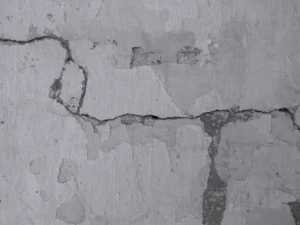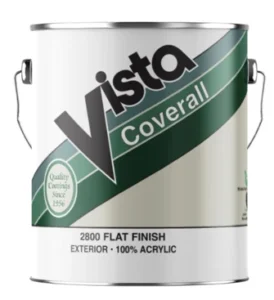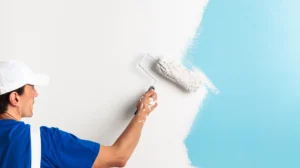
Best Paint for Wood
Painting wood protects it from the elements, from cracking and seals it so it ages well. Depending on if the wood is interior or exterior,
Painting concrete can add a lot of life and color to the otherwise boring surface. Paint protects the surface, hides discoloration and stains, reduces future mold growth and can even add color and personality. Any exterior concrete can be painted. This can include a planter, a driveway, exterior stairs, retaining walls and more.
That said, you do need to select the right paint for the job. Not every paint is labeled for outdoor use. Using the wrong paint could result in paint peeling and your project looking worse with time.
Painting concrete may not seem necessary at first given how durable concrete is on its own. However, if the concrete is going to be in a dirty area, such as a garage or under a tree that drops a lot of sap, painting the concrete makes it much easier to clean. It also adds color and can be used to either enhance or disguise a large area of concrete, such as a retaining wall.
If you have stained or ugly exterior concrete, paint can also disguise this and act as a decorative surface. Finally, painting concrete can prevent mildew and mold from developing on areas that are perpetually damp. Concrete is porous and absorbs water, meaning that as water exposure increases and decreases, your concrete could crack. Painting makes the surface of the concrete impermeable and waterproof.

Preparation is key before beginning to paint concrete. As tempting as it may be, you can’t just slap a coat of paint on concrete and call it a day. First, you need to clean the concrete. This can involve power washing it or sweeping and rinsing it. If there is dirt, the paint won’t adhere as nicely.
Concrete that has oil stains like that in a driveway or garage should be treated with an oil remover since it can interfere with the paint’s adhesion. When pressure washing concrete, keep your setting below 1,700 PSI to avoid damaging the surface.
Next, add an etching solution to remove all salt deposits and prepare the clean surface for paint. Acids are also used sometimes for this purpose, but an etching solution is less corrosive on the concrete.
Are there any cracks or splits? These should be filled promptly with the appropriate sealant. If a crack is too large or not level, you may need to patch it with new concrete. Sealant appropriate for concrete can be used for smaller cracks. If you’re painting a garage floor, take care to also seal the joint where the floor meets the wall.

Chipped areas need to be sanded smooth or filled with a concrete putty or silicone graded for outdoor use. Any chips are invitations for moisture to seep in and crack your concrete with the first freeze.
Read the sealant instructions carefully to see how long these materials take to dry and cure. Painting over wet concrete is sure to make a mess.
This step is essential – if you plan to paint, make sure not to use a concrete sealant. Paint will not adhere over sealant. Instead, moisture test the concrete after all the repair work and cleaning has been performed. If you paint over it while it’s damp, you’re locking in mold and water.
Finally, you’re ready to paint! Cut in any edges if you’re painting in a smaller space. Paint your concrete in firm stokes in one direction with a paint roller, working so you don’t have to step on the wet paint as you continue. This first coat may look a little streaky as it absorbs into the concrete.
The second coat can be applied once the concrete is dry. This can take about four hours, but do a little scrape test to be sure by rubbing your fingernail in a corner. If it seems dry, you can apply your second coat in the opposite direction of your first application. This ensures even coverage and reduces streaks in your finished product.
This will need to dry for a few days before it’s ready for use. Ideally, you want to pick a week to paint where the weather is sunny, warm and there’s little wind.

Not just any paint will do when you’re choosing to protect and decorate concrete. Indoor paint will chip in a short time and exterior all-purpose doesn’t have the durability for concrete.
Vista recommends our 2800AF Coverall Concrete Coating. This paint is specially formulated for concrete and is more flexible than your typical exterior paint. This helps the paint hold up to foot traffic, cars, weather and more.
The Coverall Concrete Coating is also formulated to avoid chalking and fading under intense UV light, meaning your painted driveway will look as good as the day you first painted it. This paint is available in white and custom colors so it can be perfectly tailored to fit your home’s exterior.
Remember, your outcomes are only as good as the preparation and tools you use. Taking time time to prep and clean your surface and choosing the right paint means you’re looking at a one-time project rather than something you’ll have to repaint annually.
One of the advantages of painting concrete is how easy the maintenance is. Sweep off surface debris and rinse away any sap, bird dropping or other stains. If you plan to power wash, which shouldn’t be necessary with a painted surface, make sure to use a setting only for paint. Otherwise you risk removing the paint from your concrete.
Should you decide to repaint a different color, simply remove the only paint via power washing or a paint stripper, prepare the surface as you did previously and apply your new paint color. Which color will you choose?
Painting your concrete, whether you’re touching up stairs, painting a garage floor or adding personality to a bird bath, can bring color to even the most mundane surface. Choosing Vista Paint for your paint needs means you’re getting a quality paint formulated especially for your needs.

Painting wood protects it from the elements, from cracking and seals it so it ages well. Depending on if the wood is interior or exterior,

Have you ever tried to paint a home that was covered in incredibly busy wallpaper? (To envision this, think of the décor and wallpaper at

You’ve just been through a big move after spending weeks packing and organizing. However, you won’t be able to feel happy and comfortable in your

Painting wood protects it from the elements, from cracking and seals it so it ages well. Depending on if the wood is interior or exterior,

Have you ever tried to paint a home that was covered in incredibly busy wallpaper? (To envision this, think of the décor and wallpaper at
© 2025 Vista Paint Corporation